
Famagusta
(Mağusa)
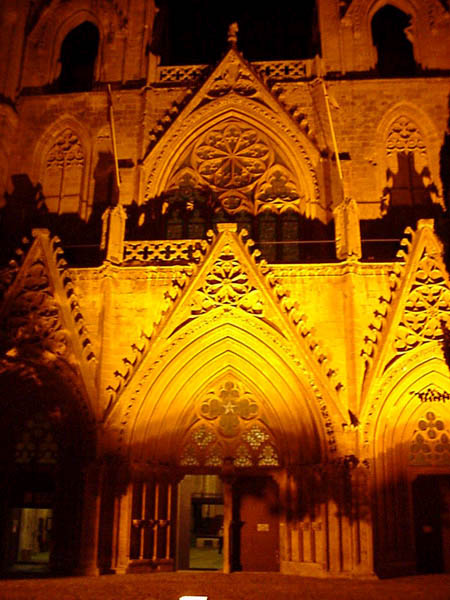 The
city of Famagusta (Mağusa in
Turkish) is one of the finest examples of mediaeval architecture in the
eastern Mediterranean and, in its present state of preservation, is
equal to that of the old cities of Carcassone and Ragusa (Dubrovnik).
The
city of Famagusta (Mağusa in
Turkish) is one of the finest examples of mediaeval architecture in the
eastern Mediterranean and, in its present state of preservation, is
equal to that of the old cities of Carcassone and Ragusa (Dubrovnik).
One full day spent in Famagusta will reveal the history of Cyprus in a
nutshell.
Much of Cyprus is an outdoor
museum, but only here is so much historical interest concentrated, that
is a showplace for all.
Much of the history of the
town is obscure as there are no written records and our only source of
material is from travellers' accounts of merchants passing through.
 Some historians declare that
it was founded by King Ptolemy Philadelphus of Egypt in 285 B.C. It is
believed that the city occupies the site of ancient town of Arsinoë.
Famagusta prospered through the destruction of the neighbouring Salamis, the former
capital of the island.
Some historians declare that
it was founded by King Ptolemy Philadelphus of Egypt in 285 B.C. It is
believed that the city occupies the site of ancient town of Arsinoë.
Famagusta prospered through the destruction of the neighbouring Salamis, the former
capital of the island.
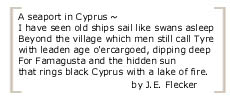 By the
year 1300 A.D. the town was one of the principal markets of the Eastern
Mediterranean, the rendezvous place of rich merchants and the
headquarters of many Christian religious orders as revealed by numerous
churches of various denominations still to be seen in the town today.
This was the time of the Crusades and when the rich Lusignan dynasty
ruled Cyprus.
By the
year 1300 A.D. the town was one of the principal markets of the Eastern
Mediterranean, the rendezvous place of rich merchants and the
headquarters of many Christian religious orders as revealed by numerous
churches of various denominations still to be seen in the town today.
This was the time of the Crusades and when the rich Lusignan dynasty
ruled Cyprus.
Lusignans fortified the town,
and in the thirteenth century built the beautiful Cathedral of St. Nicholas,
transformed since then into a mosque.
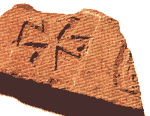 Famagusta was the seat of a
Latin diocese from the twelfth century and had residential bishops till
the end of the sixteenth. The city is protected by ramparts which
encircle the town and the citadel castle guarding the harbour, the best
in Cyprus. This citadel or
Othello's tower is the first main focus of attention for
visitors.
Famagusta was the seat of a
Latin diocese from the twelfth century and had residential bishops till
the end of the sixteenth. The city is protected by ramparts which
encircle the town and the citadel castle guarding the harbour, the best
in Cyprus. This citadel or
Othello's tower is the first main focus of attention for
visitors.
The period 1300 to 1400 is
known as the golden age of Famagusta and was regarded as such by
visiting merchants, who brought western Europe the tales of fabulous
wealth in the various places.
After 1400, rival factions
of Genoese and Venetian merchants settled there. The Genoese caused
much strife until finally the Venetians took
command of all Cyprus and transferred the capital from
Nicosia to Famagusta in 1489. The Venetians were in command for 82
years and it was from Famagusta that the whole island was governed.
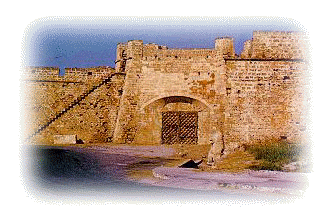
Porta del Mare (Sea Gate)
The invention of gun powder
and the use of cannon made it necessary for the Venetians to remodel
the entire defences for the use of artillery, the new type of warfare.
The mediaeval square towers were replaced with round ones and all along
the walls and citadels numerous cannon portholes were inserted.
The Ottoman
armada arrived outside the town in 1570 and put it under siege for a
year. In 1571 not only Famagusta, but all Cyprus was under Ottoman
Turkish rule and remained so until 1878. The end of the British
colonial rule in 1960 led to the intensification of inter-communal
strife between Greek-Cypriots and Turkish-Cypriots which concluded in
1974 with the Turkish-Cypriot rule in North Cyprus.
The new town of Famagusta
(also known as Marash or Varosha) lies just to the south of the walled
old-city of Famagusta.
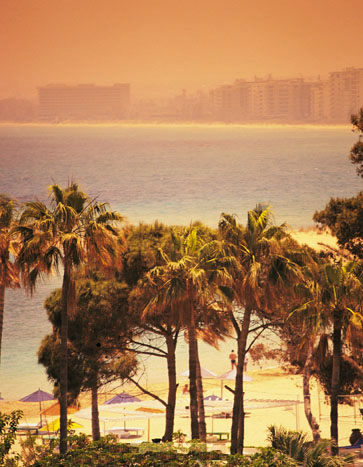
The view from Palm Beach
Today, Famagusta is a
bustling university city where Cyprus' oldest and the biggest
university Eastern
Mediterranean University is located.
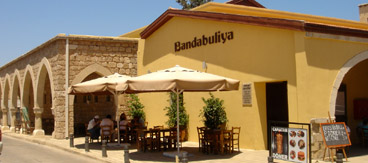
 Famagustans
love shopping as you will discover from many stores and small artisan
shops in the old city. New shops, stores, cafés and restaurants also
line up the Salamis Road on the way to the University. Like the old
traders from centuries ago, trade and shopping are part of the sine-qua-non
of a visit to Famagusta.
Famagustans
love shopping as you will discover from many stores and small artisan
shops in the old city. New shops, stores, cafés and restaurants also
line up the Salamis Road on the way to the University. Like the old
traders from centuries ago, trade and shopping are part of the sine-qua-non
of a visit to Famagusta.
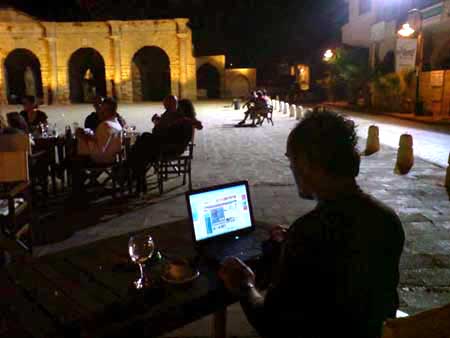
Enjoying a warm summer evening at Namık
Kemal Piazza (Photo ©
Famagusta Municipality)
Strolling in the mediaeval
old city, shopping for souvenirs or bric-a-brac, drinking your Turkish
coffee at Bandabuliya at Namık
Kemal Piazza (where there's free wi-fi internet connection), having
yummy cakes at a patisserie near Desdemona's Garden and Porta del Mare
or just walking by Laguna Beach marina with the locals at sunset
Famagusta slowly grows on one and does not leave you easily.



 Some historians declare that
it was founded by King Ptolemy Philadelphus of Egypt in 285 B.C. It is
believed that the city occupies the site of ancient town of Arsinoë.
Famagusta prospered through the destruction of the neighbouring
Some historians declare that
it was founded by King Ptolemy Philadelphus of Egypt in 285 B.C. It is
believed that the city occupies the site of ancient town of Arsinoë.
Famagusta prospered through the destruction of the neighbouring  By the
year 1300 A.D. the town was one of the principal markets of the Eastern
Mediterranean, the rendezvous place of rich merchants and the
headquarters of many Christian religious orders as revealed by numerous
churches of various denominations still to be seen in the town today.
This was the time of the Crusades and when the rich
By the
year 1300 A.D. the town was one of the principal markets of the Eastern
Mediterranean, the rendezvous place of rich merchants and the
headquarters of many Christian religious orders as revealed by numerous
churches of various denominations still to be seen in the town today.
This was the time of the Crusades and when the rich  Famagusta was the seat of a
Latin diocese from the twelfth century and had residential bishops till
the end of the sixteenth. The city is protected by ramparts which
encircle the town and the citadel castle guarding the harbour, the best
in Cyprus. This citadel or
Famagusta was the seat of a
Latin diocese from the twelfth century and had residential bishops till
the end of the sixteenth. The city is protected by ramparts which
encircle the town and the citadel castle guarding the harbour, the best
in Cyprus. This citadel or 


 Famagustans
love shopping as you will discover from many stores and small artisan
shops in the old city. New shops, stores, cafés and restaurants also
line up the Salamis Road on the way to the University. Like the old
traders from centuries ago, trade and shopping are part of the sine-qua-non
of a visit to Famagusta.
Famagustans
love shopping as you will discover from many stores and small artisan
shops in the old city. New shops, stores, cafés and restaurants also
line up the Salamis Road on the way to the University. Like the old
traders from centuries ago, trade and shopping are part of the sine-qua-non
of a visit to Famagusta.
